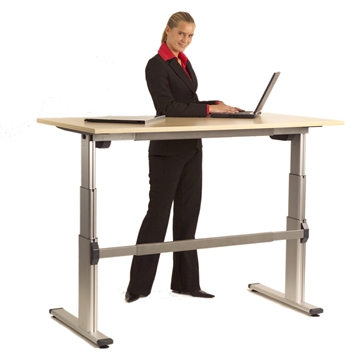 Add My Company
Add My Company
Sign In

Many adults in the UK now spend more than 7 hours a day sitting, and this typically increases to 10 hours or more the older we get. This is hardly surprising when you consider our daily routines, such as being sat at our desks and being sat in the car. The main issue with this, is that our bodies are not engineered to be sat in a static position all day. Long periods of sitting have a major impact on our health and wellbeing. This can include strain on our necks, herniated discs, muscle degeneration and weakened bones, these are just some of the problems involved around the issue of sitting for too long. By implementing a standing desk into your workstation, this will help combat these symptoms as well as giving your body a chance to experience all the health benefits that go alongside it. Having the ability to switch between standing and sitting postures can help reduce the physical stress which your body has to endure. It keeps you active at work, and improves your productivity throughout the day. Sit-stand desks are recommended by the London Spine Clinic, as they have been designed in a way which makes working comfortable whether you’re stood up of sat down. It gives you the ability to vary your posture and combat the health risks which are associated with sitting too much.
The use of sit-stand desks, has been scientifically proven to improve your productivity, concentration and increase your creativity. The reason for this, is whilst your standing some of the body’s largest muscles are working, so this increases blood flow to the brain. Therefore, it improves the way we feel and improves the way we work. It has also been found that sit-stand desks have the ability to increase productivity from up to 10-20%.
As well as becoming more productive, sit-stand desks will lead to much greater health than those who sit for an extensive period of time. It has been discovered that office workers spend 65% to 75% of their working hours sitting down, the majority of this takes place in prolonged periods of sustained sittings. A study published in the British Journal of Sports Medicine, showed that compared with those who sit the least, those who sit the most are more than twice as likely to develop type 2 diabetes and cardiovascular disease and have a 13% and 17% increased risk of cancer incidence and mortality respectively.
As mentioned in an above paragraph, it requires the use of more muscles, so it’s no surprise that you burn more calories whilst using a sit-stand desk due to the increase in blood flow. Standing uses around 13 per cent more energy over the course of an eight-hour day, says Dr Dunstan, who is head of physical activity at Baker IDI Heart and Diabetes Institute. This accumulates to four hours standing burning the equivalent to what you would if you went on a 45-minute walk.
Sit-stand desks don’t just have long term benefits, as they are also extremely beneficial in the short term for the body. Standing helps prevent a harmful build-up of sugars and fats in your blood, as a result workers who stand more have better energy levels and concentration.
Here is a basic step to step guide in how to get the most out of your sit-stand desk.
1. To decide the height of the standing desk, relax your shoulder and create a 90-degree angle with your elbow.
2. Bring the desk height to just below the forearm.
3. Your thighs should run parallel to the ground, with your feet firmly placed on the floor, shoulder width apart.
4. Wrists must be in line with your forearms.
5. Keep your head upright with ears in line with your shoulders. Eyes should be in line with the top one third of the screen.
6. You will also find that your posture will be at its best, when your rib cage is above your hips, as this means that you’re not leaning forward or backwards.
7. Finally, your knees should be straight, however not locked, if knees are locked you are likely to be bending too far back, this causing strain on your lower back and pelvis.
It is recommended, that when working at your desk you should spend at least a minimum of two hours on your feet, this with the main aim of reaching an ideal four hours. Seated work needs to be regularly broken up with standing work. As well as avoiding too much seated work, remaining in a static standing posture should also be avoided. This being why its advised to regularly charge or shift weight between your legs, in order to reduce leg fatigue. As well as shifting weight, you should also frequently adjust the posture of your body throughout the working day. Occupational standing has not been shown to cause any damage towards your lower back or your neck, if anything standing helps to provide relief towards the muscles.
People who are new to standing based work, may experience some musculoskeletal sensations and fatigue, as the body still needs to adapt to its new way of working. If these pains don’t decrease after changing posture or going on a walk, then it’s suggested for the worker to have a rest. This being in a position that helps to relieve all sensations. If there are still issues after this, then medical advice should be sought after. It is crucial, that employees promote to their staff that prolonged time sitting can dramatically increase someone’s risk of cardio metabolic diseases and premature death.
www.posturegroup.co.uk
http://www.posturegroup.co.uk/blog/benefits-of-sit-stand-desks-on-your-posture-and-work-health-and-wellbeing
For more information on Benefits of sit stand desks on your posture and work health & wellbeing talk to Relaxa Posture Group
Enquire Now
List your company on FindTheNeedle.

